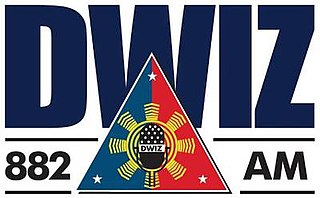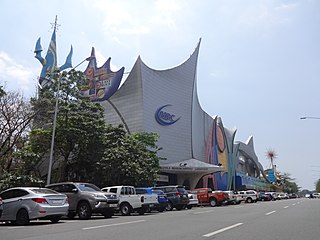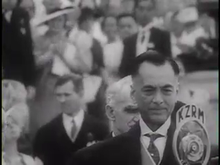
DWRR-FM, broadcasting as MOR 101.9, was a commercial radio station owned by ABS-CBN Corporation and previously operated by the Manila Radio division and the Star Creatives Group. Broadcast live throughout the Philippine archipelago, and throughout the world via The Filipino Channel (TFC), it was the flagship FM station of MOR Philippines and the number 1 FM radio station in Metro Manila, Mega Manila as well as the entire Philippines according to KBP Radio Research Council. The studios were located at ABS-CBN Broadcasting Center, Sgt. Esguerra Ave., corner Mo. Ignacia Ave., Diliman, Quezon City, and the station's 22.5 kW FM stereo transmitter was located at the Eugenio Lopez Center, Santa Cruz, Sumulong Highway, Antipolo, Rizal.

DZBBSuper Radyo is a radio station owned and operated by GMA Network. It serves as the flagship station of the Super Radyo network and one of the assets of GMA Radio and GMA Integrated News. The station's studio is located at the 3rd floor of GMA Network Studio Annex, EDSA corner GMA Network Drive, Diliman, Quezon City, while its transmitter is located along Camia St., Brgy. Panghulo, Obando, Bulacan.
DZRJRadyo Bandido is a radio station owned and operated by Rajah Broadcasting Network through its licensee Free Air Broadcasting Network, Inc. Its studio is located at the 2nd Floor, Ventures I Building, Makati Avenue corner General Luna Street, Barangay Poblacion, Makati, while its transmitter is located along Km. 21 Quirino Highway, Barangay Pasong Putik, Novaliches, Quezon City.

DWIZ is a radio station owned and operated by Aliw Broadcasting Corporation, a subsidiary of the ALC Group of Companies. It serves as the flagship station of the DWIZ network, which was established in late January 2023. The station's studio is located at the 5th Floor, Citystate Centre, 709 Shaw Boulevard, Brgy. Oranbo, Pasig, and its transmitter is located along Osmeña St., Brgy. Pag-Asa, Obando, Bulacan.

DWLS, broadcasting as Barangay LS 97.1, is a radio station owned and operated by GMA Network. It serves as the flagship station of Barangay FM. The station's studio is located at the 3rd floor of GMA Network Studio Annex, EDSA corner GMA Network Drive, Diliman, Quezon City, and its transmitter is located at GMA Tower of Power, Brgy. Culiat, Tandang Sora, Quezon City.

MBC Media Group, more commonly known by its former name Manila Broadcasting Company or simply MBC, is a multimedia company in the Philippines. It is currently owned by the FJE Group of Companies of Fred J. Elizalde, which also operates hotels and Pasay-based amusement park, Star City. Its AM flagship network, DZRH is the oldest radio station in the country while its FM flagship network, Love Radio is the top station in FM radio ratings in Metro Manila and several key cities and provinces.

DWSM, broadcasting as 102.7 Star FM, is a radio station owned and operated by Bombo Radyo Philippines through its licensee People's Broadcasting Service, Inc. Its studio, offices and transmitter are located at Unit D, 18th floor, Strata 2000, F. Ortigas Jr. Ave., Ortigas Center, Pasig. Its news center, which hosts Bombo Radyo's flagship national newscast Bombo Network News, is located at Florete Bldg., 2406 Nobel St. cor. Edison St., Makati. It operates daily from 4:00 AM to 12:00 MN.

DZRJ, broadcasting as 100.3 RJFM, is a radio station owned and operated by Rajah Broadcasting Network through its licensee Free Air Broadcasting Network, Inc. The station's studio is located at 7849 General Luna Street corner Makati Avenue, Barangay Poblacion, Makati, while its transmitter is located along Merano St., Barangay San Roque, Antipolo. It operates 24 hours a day.

DZMB, broadcasting as 90.7 Love Radio, is a radio station owned and operated by MBC Media Group though its licensee Cebu Broadcasting Company. It serves as the flagship station of Love Radio Network. The station's studio is located at the Second Floor, MBC Building, Star City, Vicente Sotto St., CCP Complex, Roxas Boulevard, Pasay; while its transmitter is located at the BSA Twin Towers, Bank Drive, Ortigas Center, Mandaluyong, sharing the same site with 96.3 Easy Rock and 101.1 Yes FM.

The Presidential Broadcast Service - Bureau of Broadcast Services (PBS-BBS), is a state radio network owned by the Philippine government under the Presidential Communications Office (PCO).

DZRB, on-air as Radyo Pilipinas Uno (RP1) or RP1 News, is a radio station owned and operated by the Presidential Broadcast Service, an attached agency under the Presidential Communications Office. It serves as the flagship station of the Radyo Pilipinas network. The station's studios are located at the 4/F, PIA/Media Center Building, Visayas Ave., Brgy. Vasra, Diliman, Quezon City, and its transmitter is located at Brgy. Marulas, Valenzuela City. The station operates Weekdays from 5:00 AM to 12:00 MN and Weekends from 6:00 AM to 10:00 PM.

Catholic Media Network, also known as CMN, is a Catholic radio network in the Philippines. CMN serves as the broadcasting arm of the Catholic Bishops' Conference of the Philippines, the governing body of the Roman Catholic Church in the Philippines.

Radio Mindanao Network, Inc. (RMN), d.b.a. RMN Networks or RMN Network, is a Filipino media company based in Makati, Philippines. It is primarily involved is one of the largest radio networks. Its corporate office is located at the 4th Floor State Condominium I Bldg, Salcedo St., Legaspi Village, Makati, and its main headquarters are located at the RMN Broadcast Center, Don Apolinario Velez St., Cagayan de Oro.

Nation Broadcasting Corporation (NBC) is a Philippine radio and television Broadcast company established in 1963. As of December 2013, NBC is a subsidiary of MediaQuest Holdings, Inc. under the PLDT Beneficial Trust Fund. NBC's radio and television stations are operated by sister network TV5 Network, Inc.; its corporate offices and studios are shared with the latter at the TV5 Media Center, Reliance cor. Sheridan Sts., Mandaluyong, Metro Manila, Philippines.

DXWT, broadcasting as 92.3 Wild FM, is a radio station owned and operated by the UM Broadcasting Network. It serves as the flagship station of the Wild FM network. The station's studio is located at the UMBN Media Center, C. Bangoy cor. Palma Gil St., Davao City, and its transmitter is located along Broadcast Ave., Shrine Hills, Matina, Davao City.

Radyo Pilipino Corporation, presently operating as Radyo Pilipino Media Group, is a Philippine broadcasting company owned by Lucky Star Holdings. Originally founded in 1924, it is the oldest radio network in the Philippines; its current incarnation was founded on June 25, 1985, by a consortium led by businessman-politician Eduardo Cojuangco Jr.
DWRT-AM was an AM music radio station owned and operated by Trans-Radio Broadcasting Corporation in the Philippines. Since September 9, 2010, the 990 kHz frequency has been airing under the call sign DZIQ-AM, through a blocktime arrangement.

DYRCAksyon Radyo is a radio station owned and operated by MBC Media Group. It serves as the flagship radio station of MBC's regional AM network Aksyon Radyo. The station's studio is located at 2nd Floor, GD Uyfang Bldg., Sanciangko cor. Panganiban, St., Brgy. Pahina Central, Cebu City, and its transmitter is located at Brgy. Tangke, Talisay, Cebu.
DWSS was a radio station owned and operated by FBS Radio Network through its licensee Supreme Broadcasting System. The station's studio was located at Paragon Plaza Condominium, EDSA corner Reliance St., Mandaluyong, while its transmitter was located along Coloong 1 Rd., Brgy. Caloong, Valenzuela City.
Broadcast media is being utilized by the Members Church of God International (MCGI), an international Christian religious organization with headquarters in the Philippines, to preach the gospel and expand internationally. The church is producing religious programs in different languages, aired in various countries, by acquiring time slots on several television stations. The church also maintains its own radio and television network for its 24/7 terrestrial, satellite and internet broadcasts.

















